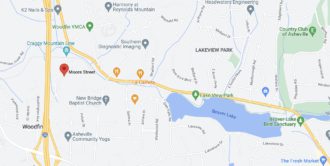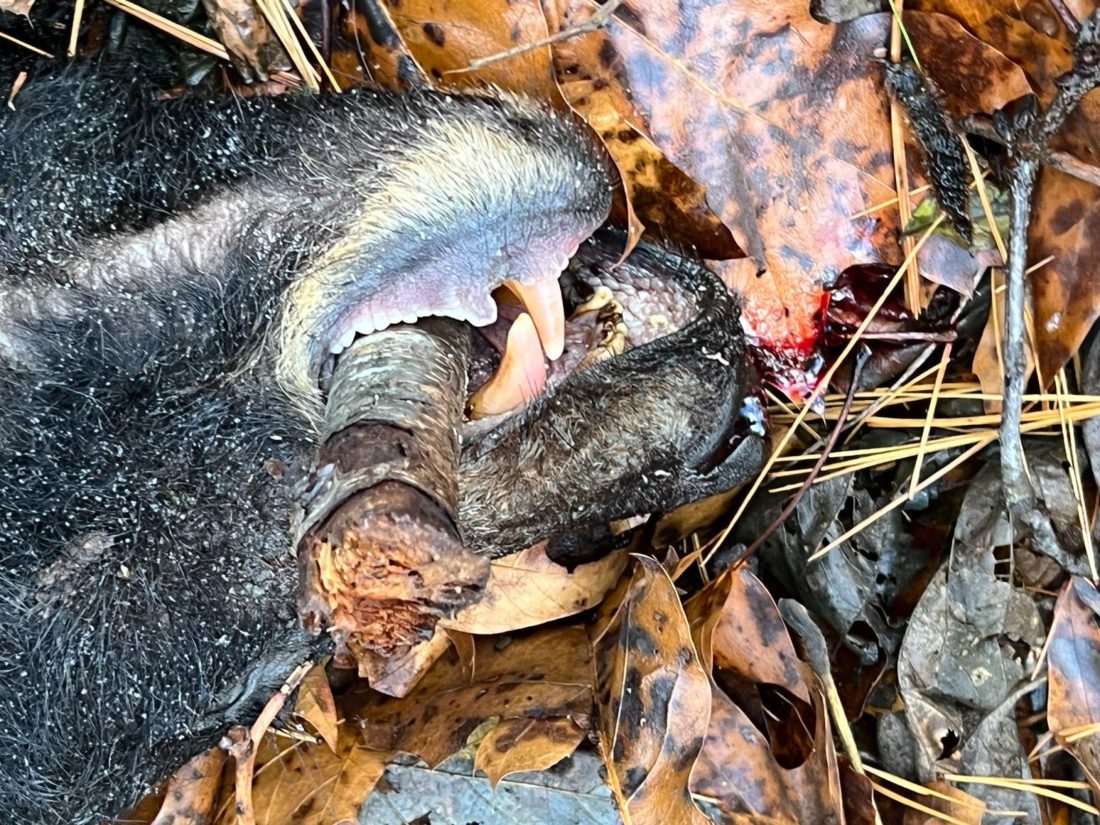By John Boyle, Asheville Watchdog
The remains of three bears found in Woodfin — possibly a mother and two cubs — highlight a serious problem with poaching in the mountains, a bear advocacy group says.
The N.C. Wildlife Resources Commission said the case may be the result of poaching, but its investigation is ongoing. Poaching is a serious problem in the mountains, Wildlife Resources Sgt. Brandon Bryson said, but hunters also sometimes just dump carcasses.
“This time of year we get a lot of complaints about people dumping bear and deer carcasses, because the seasons are current,” Bryson said, referring to hunting seasons. “They pick random places. That particular location is somewhere that is easily accessible off the road, not that far from the interstate, so someone could’ve used it as a dumping area.”

Bryson confirmed Dec. 1 the animals were found off private property off Moore Street. Wildlife Resources is investigating the case, but the agency has not determined the cause of death for the bears, or if they were a mother and cubs.
“Three bears — that’s what we could determine,” Bryson said, adding that they don’t know the age or sex yet. “We’re going to contact our biologist and see if they can’t get a little more specific information.”
The Help Asheville Bears advocacy group has offered a $5,000 reward in the case, posting a video on its Facebook page. The group identified the dead bears as a mother and two cubs.
Paws missing, or not?
The HAB Facebook page says the bears “were skinned, their paws were removed, and their entrails were placed in a large plastic bucket that was left with their remains.”
HAB Founder Jody Williams said the case is “a sad situation.”
“There’s not much left of the bodies at all,” he said. “There was only one paw left.”
Controversy has swirled about the issue of poachers killing bears for their paws, viewed as trophies in some circles.
Bryson, who supervises Buncombe, Haywood and Madison counties, said they have no evidence of that in this case. In fact, the investigator in this case recovered numerous bear paws.
“We found eight of them, maybe more,” Bryson said. “We don’t believe there’s any type of removing the paws for some sort of criminal activity in the area.”
There is a global market for bear parts, including for bear paws, Bryson said, although he added that it’s been “on the decline the last several years.”
Bear legs are removed during skinning for meat.
“Sometimes they’re removed with the leg a little further up in skinning an animal,” Bryson said, referring to people harvesting the meat. “And where they were cut off at [in this case], that’s what that looked like.”
Poaching a serious problem in WNC
Poaching — the illegal killing of game animals — happens frequently in the mountains, Bryson acknowledged.
Asked if Western North Carolina has a serious problem with poaching, Bryson responded, “A serious problem with poaching? Yes. With the sale of black bears on the black market? No.”
But like other game animals, black bears are killed illegally every year.
Hunters legally can take one black bear per season, and the animal has to weigh at least 75 pounds. The first part of bear season in the mountains ran from Oct. 17– Nov. 19, and the second part runs from Dec. 12– Jan. 2, according to the WRC website.
“From Asheville west over the past few years, we’ve had over 150 charges that solely involved the illegal taking of black bears,” Bryson said. “Whether that is illegal baiting or hunting during the closed season, etc.”
For 2021, hunters legally killed 2,371 black bears in North Carolina, according to WRC statistics. That includes 1,230 bears taken in the western region.
Poaching of other game animals is a problem, too, Bryson said.
“We have a lot of illegal poaching activity — we stay very busy,” he said. “But in regards to the illegal black market sale of black bear parts, not in the current (climate) in this area.”
Williams, the HAB founder, maintains that poaching is “more common than Wildlife (Resources) will let on.”
“Anywhere bears are — or any animal, really — they’re being poached,” Williams said. “People do not follow the law.”
Williams said his group has reported cases of poaching of deer, turkeys, bald eagles, and other animals.
“People just don’t follow the law, and the bear part trade is alive and well,” Williams said. “There’s paws and gall bladders being sold everywhere.”
Poaching for ‘the sport of it’
Poachers often are after the animal’s meat, Bryson said, but they also sometimes have more cold-hearted motives — “the sport of it,” he said.
“We have a big problem with people spotlighting deer at night,” Bryson said. “Night deer hunting we call it, and a lot of times they will just leave those. They’ll do it for sport. We’ve caught people in poaching rings who have bets to see who can kill the most and leave them.”
Poaching is a misdemeanor offense, he said.
The investigation is ongoing in the Woodfin case, Bryson stressed.
“It may have been a hunter; it may not have been a hunter,” Bryson said. “We try to distinguish (between) a hunter and a poacher. They’re not the same thing.”
Cause of death not clear
Bryson said it was not immediately clear what the cause of death was for the bears in Woodfin.
“I could not tell (if there) was a gunshot wound or anything, but the meat had been removed,” Bryson said. “We have had them killed in the past — more than one bear at one time, if they’re small — by vehicles.”
But he added “that’s pretty unlikely, obviously,” in this case, “with the meat being removed.”
In cases like the Woodfin incident, a necropsy [an autopsy of an animal] is unlikely, Bryson said.
“It’s just not practical to do that on every dead animal,” Bryson said. “We have one biologist that serves pretty well the western 17 counties, and we pretty much wear him out as is.”
If an investigation leads to multiple culprits or incidents, that may change things. In some cases, Wildlife Resources has sent DNA samples to the University of Tennessee for analysis.
“With this particular thing, we don’t know if it’s isolated or not,” Bryson said. “This is not the only place I could take you to this hunting season that has a couple of bear carcasses dumped.”
“So as of right now, this one doesn’t look any more unique than other ones in the area,” Bryson continued. “We do take it very seriously, of course. This is what we do.”
It was also impossible to determine if the gall bladders had been taken in this case, Bryson said, because of decomposition and the possibility of scavengers removing body parts. Bear gall bladders are prized for alleged medicinal purposes in some markets, particularly China.
“We couldn’t tell if they were intact, but there was what looked like a bucket of the entrails,” Bryson said. “We couldn’t differentiate what was in there, because of what had decomposed and what small animals had drug off.”
Asheville Watchdog is a nonprofit news team producing stories that matter to Asheville and Buncombe County. John Boyle is an award-winning reporter who has been covering Asheville and surrounding communities since the 20th century. You can reach him at (828) 337-0941, or via email at jboyle@avlwatchdog.org.




Excellent reporting from an experienced journalist in the true sense of the word, – rare these days.
Mr. Boyle negotiates this tricky story by quoting both parties, obviously at odds as to what might have happened at the Woodfin scene.
He draws no conclusions, allowing the reader to make up his or her own mind as to the possibilities.
We have the founder and prime mover of the HAB non-profit on one side, and an experienced officer with the NC Wildlife Resources Commision on the other.
Mr. Williams claims that his party found obvious pouching remains, identifying them as a female and two cubs. He states that most all the paws were removed. Mr. Williams then makes several more general statements, not necessarily having a connection with the Woodfin scene. For example, we are informed that poaching is “more common than Wildlife (Resources) will let on”, without providing a source.
We then learn that HAB’s position is that “Anywhere bears are — or any animal, really — they’re being poached,” Williams said. “People do not follow the law.”
He adds that the bear trade is alive and well, with… “paws and gall bladders being sold everywhere.” He does not specify where exactly, but one would infer that he means right here in the mountains surrounding Asheville. Of course, a non-profit advocacy group such as Help Asheville Bears does depend mightily on its ability to raise funds from donors who feel a strong sense of helping to right a terrible wrong. And for that they are to be encouraged and admired. However, this appears in some ways to be a case of overselling.
Or are we to believe that Officer Bryson is deliberately downplaying, – misleading really, – what is going on here? Why would an experienced officer, obviously dedicated to protecting the states wildlife, sometimes in dangerous situations alone, – why would he want to mislead the public? Why would the state Wildlife Commission choose to lie about – or as Mr. Williams puts it – not let on how prevalent poaching really is? It does not make sense that either Officer Bryson or the state would want to, or have any motive to, mislead the public in this matter.
An interesting aspect of this story, one that I would love to see Mr. Boyle follow-up on, would be if donations to the HAB group increase noticeably following the publication of this story.
Thank you, Mr. Boyle, for a compelling report on a very cultural and generational story of life in the WC Mountains.
You have given the reader the opportunity to ponder and think on this situation, and to make up their own mind.
I have made up mine.